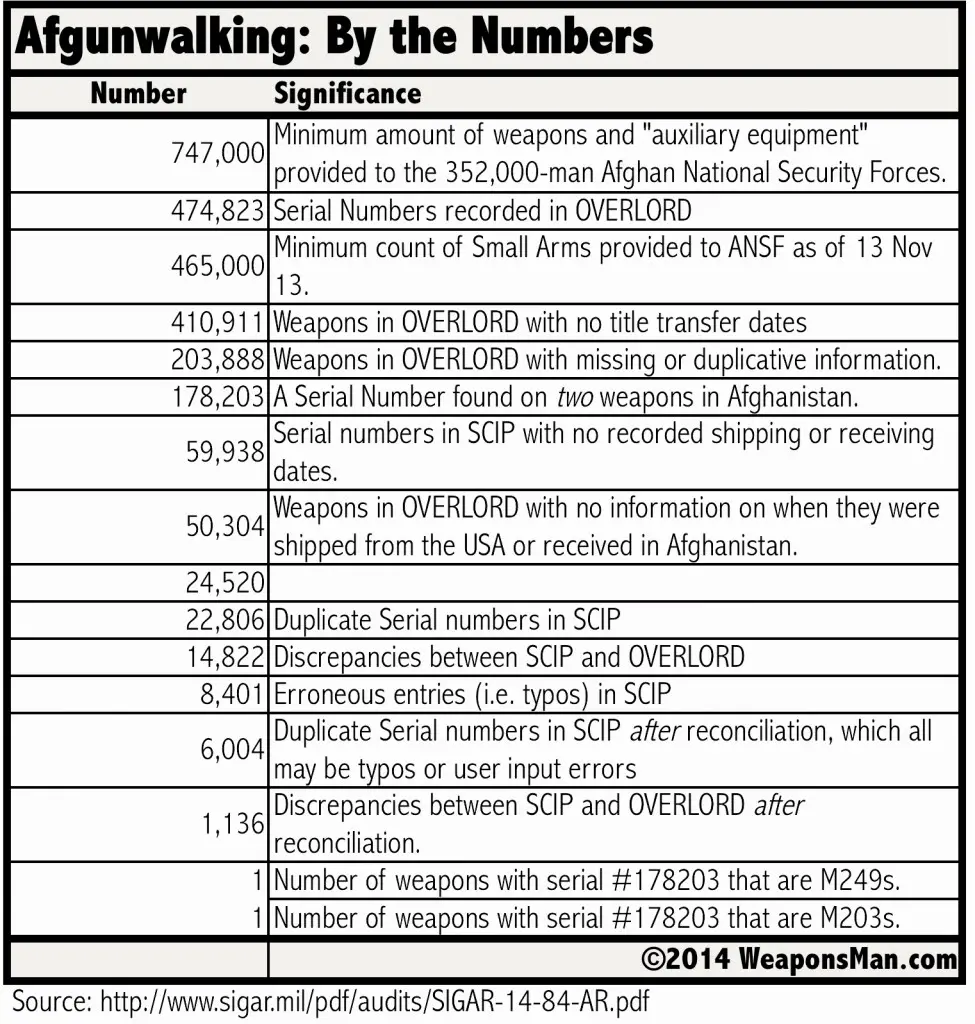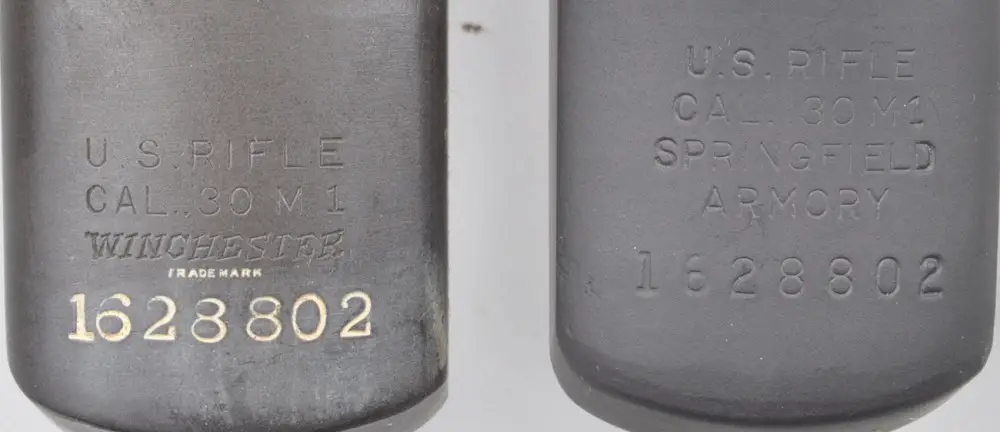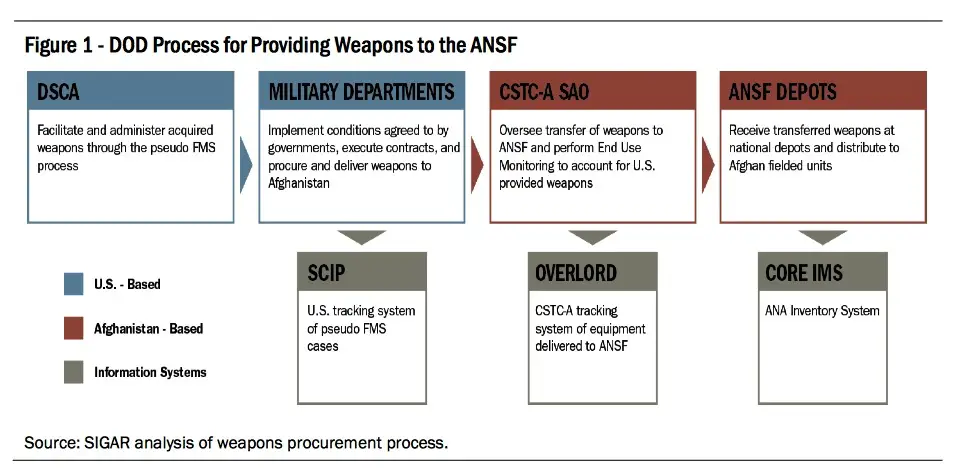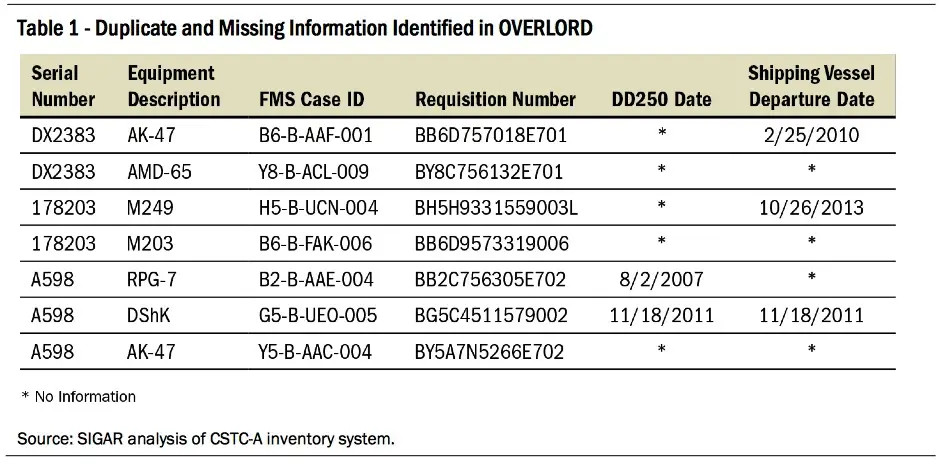So, we saw this at Miguel’s, which led us to Fox News, which led us to the Washington Times, which still didn’t give up the primary source document. We wanted the primary source document because the numbers in the Times’s story didn’t add up.
The essential claims in these media versions of the story are:
- The Afghans have lost or sold off tens of thousands of the guns we gave them; and,
- The databases are poisoned with many duplicates; and,
- Most or many of the US-provided weapons were never entered in the database; therefore:
- Accountability for weapons in the Afghan National Security Forces (ANA/ANP) is nonexistent.
Here are the numbers as we pulled them from the report, and as the media spun ’em:

Source, linked: http://www.sigar.mil/pdf/audits/SIGAR-14-84-AR.pdf
The narrative is that the Afghan National Army has lost tens if not hundreds of thousands of small arms, and that as a result We Are Doomed. It took some doing (anyone who thinks Obamacare’s website was uniquely mishandled has spent no time among the web gardens of the .gov or .mil) but we did unearth the document.
Two Databases Stood Back-to-Back, Refusing to Say a Word…
The problem is at once more complex, more nuanced, and more interesting than that. And for gloom and doom fans, we’re probably still doomed. The bottom line is that the US’s incredibly complex and inefficient inventory systems, which famously do not talk to one another, also don’t mesh with the inventory system we provided to Afghanistan. Three completely different (and fundamentally incompatible) IT systems track US-provided small arms in OEF. Those systems include:
- SCIP, the Security Cooperation Information Portal, used in the USA by logisticians supplying materiel to American allies worldwide.
- OVERLORD, the Operational Verification of Reliable Logistics Oversight Database, developed in-country by the Combined Security Transition Command-Afghanistan (CSTC-A), the latest of several names for the US training HQ in-country.
- CoreIMS, the Core Inventory Management System, a US-spec COTS inventory database that has been foisted off on our valiant Afghan allies.
Here’s a graphic from that famous primary source document that the Times and Fox wouldn’t show you, preferring to predigest your informational meal. (Here’s a link to the document: SIGAR 14-84.pdf. We’ve saved a copy in case the link goes tango uniform). This shows what the Special Inspector General for Afghan Reconstruction thinks the process is:
So what we have turns out to be, not vast numbers of guns vanishing as they take each step along the pipeline, but three different and incompatible databases having data that are at odds with one another.
Which database is right? Who knows? Could be any of them. Or none of them! In fact, all three databases could have wide discrepancies, and yet none of them have totals close to what actually exists in inventory.
But it turns out, if you actually read the SIGAR report instead of act like a Media Luminary and Skim Until Shocked, the auditors did that, and as it turns out, some of the numbers are before they deep-dove the data, and some of the numbers don’t represent what they appear to represent. Yes, Afghan inventories are a mess, but they’re not the mess the news stories describe. A spot check of weapons in storage at the ANA Kandahar depot, for example, found the weapons in the crates the database said they’d be in, and traced every weapon back in inventories that matched the weapons on site. A similar exercise at the ANP 22 Bunkers Depot appeared to have similar results, but the inspectors didn’t have time to complete the inspection. True, other depots and units had more fragmentary records, and the ANA Central Supply Depot’s records were far off from what was inventoried on site. But by Afghan standards, it wasn’t all that bad.
Remember that the idea of weapons inventories was something that Afghans have never done, except when compelled by Soviet or NATO allies. That they don’t do it as well as the US DOD, while using a stack of incompatible and user-hostile systems imposed from outside, shouldn’t shock anybody.
If you’re an old Afghan hand, one fundamental error in this whole process will have jumped out at you from the very beginning: trying to impose a sophisticated Western computer system (actually, multiple systems; a fourth incompatible database called ULTRA, Universal Listing of Transactions for Record Accounting, is under construction for the ANP) on a nation of Iron Age illiterates. Illiteracy was 94% to 97% when we first went into Afghanistan (the Taliban had closed all schools except madrassas). Illiterates make weak computer operators, something that American loggies never considered for a minute before deciding to spin up the Afghans in Microsoft World. Results predictable:
According to CSTC-A officials, efforts to develop the capabilities of ANSF personnel to manage the central depots have been hindered by the lack of basic education or skills among ANSF personnel and frequent turnover of Afghan staff.
Gee, there’s a shocker. We impose US-style personnel turbulence and military bureaucracy on an ally where most of the population is illiterate and borderline innumerate, and as Wilkins Micawber might say, “results, misery.”
The Duplicate Serials Problem: Not Such a Big Deal
Then, there’s the duplicate serial numbers problem , which comes to rise for two reasons:
- The procurers, developers and operators of the system did not understand that different weapon makes and models may indeed use the same serial numbers, and different manufacturers may use the same serial numbers for their versions of the same firearm, and so they erred in trying to use serial number by itself as a unique key;
- Lack of communication between databases
Even the authors of the report don’t seem to find that their discovery of some duplicate numbers is meaningless. Here’s their table from the report:
¡Ay, Chihuahua! (Old Afghan phrase). Yes, it’s not just an Afghan thing to have two weapons with the same serial number. Heck, the USA did it:

M1 Rifle Serial 1,628,802: these twin receivers were sold by CMP at auction recently.
Someone who knows weapons can clear these three discrepancies in about two tenths of a second. Like this:
- DX2383 needs to be reconciled by eyes-on physical inventory, because it’s possible that this represents two different guns, but because an AMD-65 is a variant of AK-47, it’s equally possible that this is one gun described two ways. Several manufacturers made AK variants using serial numbers of this pattern, so only physical inventory can establish whether we’re talking about one gun or two here.
- 178203 is obviously two different weapons, and a properly constructed database would not confuse an M203 with an M249 of the same serial number.
- A598 is the very same problem, Russian-designed-weapons style.
As anyone who’s ever accounted for any significant quantity of firearms can tell you, serial numbers are only likely to be unique on a single type (i.e. make/model/caliber) of weapon made for a single customer by a single manufacturer. Now, we’re not sure what other US arms have duped serial numbers like the M1 example above. (We know M16A1 rifles and XM177 “submachine guns” had absolutely unique numbers because manufacturers had independent sN blocks).
But this duplication is spun by SIGAR, in their ignorance of firearms, as a major problem, and it is spun in turn by the media as a Chicken Little sky-is-falling moment. It’s only a problem because the database designers and auditors are ignorant of the limits of serial numbering.
We certainly admit that the SIGAR report does identify some real challenges facing Afghan services on weapons-inventory issues, and it points up the poor visibility into those issues that US service elements, including CSTC-A, have into Afghan inventories. As far as the weaknesses of Afghan inventory controls are concerned, this is news to us in which way? We were pleasantly surprised to see that some Afghan National Police elements are tracking their assigned weapons using Microsoft Excel. This means they have some literate cops, who can even use computers — that’s miles ahead of 2002, let us tell you. But the SIGAR is shocked by this, and by the fact they’re not using some high-dollar, centralized, fiddly data management system instead of Excel.
Crawl, walk, run, people. Trying to drop Afghans into RDBMS management when they not only haven’t got the hang of Excel, but are largely utterly unlettered, is asking for trouble.
One is reminded of Lawrence’s maxim not to do things for the locals, but to let them do it themselves, however imperfectly.

Kevin was a former Special Forces weapons man (MOS 18B, before the 18 series, 11B with Skill Qualification Indicator of S). His focus was on weapons: their history, effects and employment. He started WeaponsMan.com in 2011 and operated it until he passed away in 2017. His work is being preserved here at the request of his family.



6 thoughts on “Land of the Lost… Guns: Afghanistan”
I’m going to save this one to my hard disk for use as an example when trying to explain database issues to people.
For many years my title was “system administrator”, but I spent most of my time writing gateways to move data between incompatble medical database systems back in the pre-HIPAA days. After a while you feel like drilling holes in your head to let the evil spirits out.
One of my favorite stories was from Canadian acquaintance in the same line of work; he started getting a bunch of complaints about geriatric patients having their records mixed in with infants. The problem (this was long before Y2K was that their system only used two-digit date codes. As Roedy noted, “There are people over 100 years old, and many of them are in hospitals.”
Just general data entry stories could fill a monograph, if not a book. Even problems like “no middle name”, which goes back to the very beginning of data processing, recur with disappointing frequency. Couple that to “field checking” that demands that *something* be in every field, and your end users will eventually get downright inventive in what they put in that field…
If someone offers you the choice between shoveling out a pig sty and cleaning up a dirty database, go for the pig sty. At least you’ll know when you’re done…
One of the things about computers is that you don’t ever delete anything. You simply change the address of the data/file and it gets overwritten (Hopefully sooner than later). When (not if) something goes wrong you can get all sorts of screwed up info. So much for calling them “Labor Saving Devices”.
I don’t know how we would do without computers but sometimes I find myself remembering how it was before computers, cell phones , satellites, and the internet. (Simpler times)
I LIKE Micawber’s principle, “Annual income twenty pounds, annual expenditure nineteen pounds nineteen and six, result happiness. Annual income twenty pounds, annual expenditure twenty pounds nought and six, result misery.”
And let’s not lose heart; “something [in your choice of caliber] will turn up.“
Of course, for good old Wilkins, it did, and he emigrated and became a great success in Australia. A great deal of misery in this world has ignorance or denial of Micawber’s Principle at its root. Timothy was almost right: “The mismanagement of money is the root of all evils.”
So then, what shall we do about the advertisers?
If you massage people with ads promoting needless consumption, most of them are going to cave in eventually and thus go into debt.
Ok, for those of you who haven’t figured it out yet the missing weapons that have no shipping date from the U.S. probably went to the Justice Department for further shipement to the drug cartels in Mexico. They need our support too.
Probably just aas worthy as the Afganistan war lords.